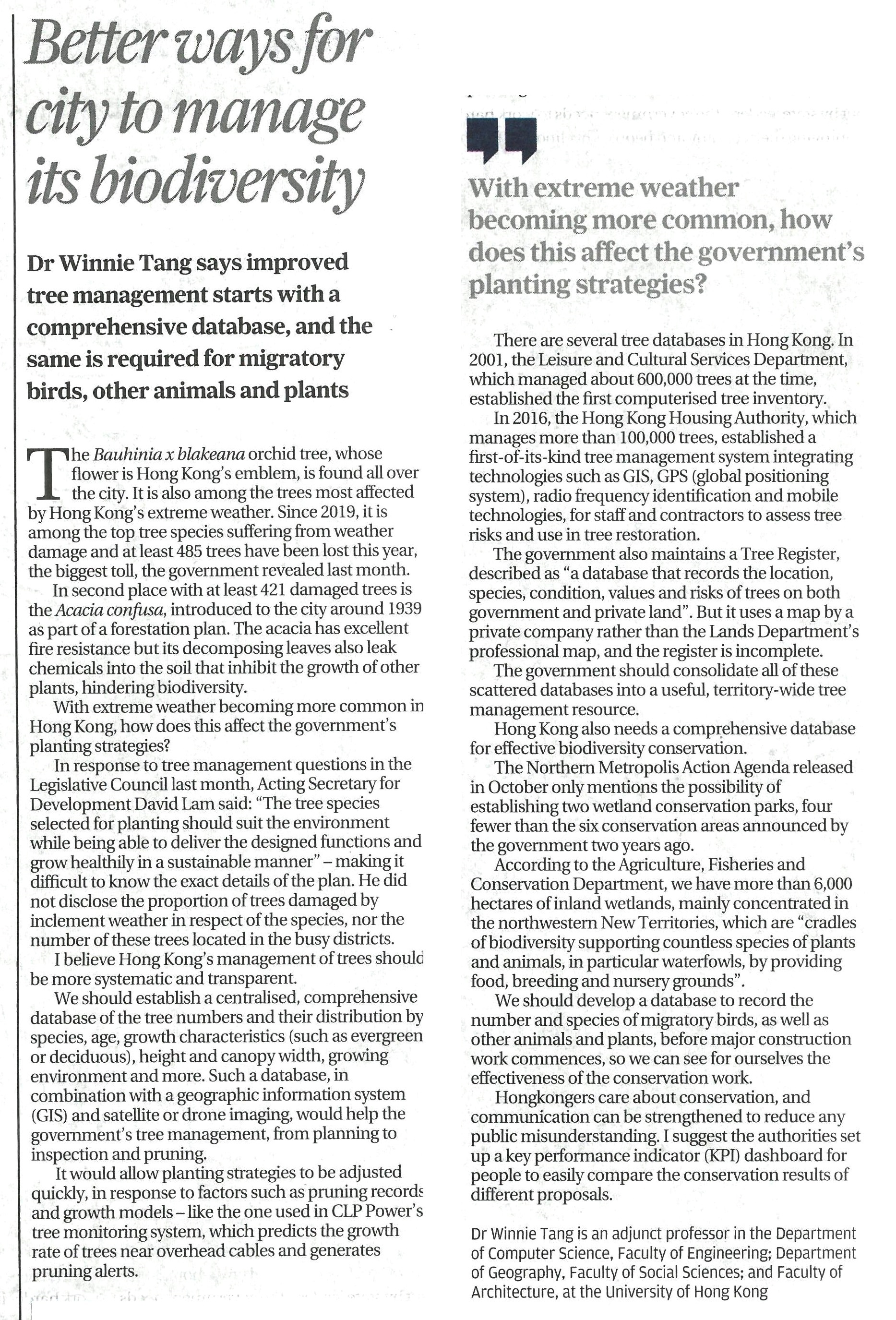網上版請按此

Better ways for city to manage its biodiversity
The Bauhinia x blakeana orchid tree, whose flower is Hong Kong's emblem, is found all over the city. It is also among the trees most affected by Hong Kong's extreme weather. Since 2019, it is among the top tree species suffering from weather damage and has lost at least 485 trees this year, the biggest toll, the government revealed last month.
In second place with at least 421 damaged trees is the Acacia confusa, introduced to the city around 1939 as part of a forestation plan. The acacia has excellent fire resistance but its decomposing leaves also leak chemicals into the soil that inhibit the growth of other plants, hindering biodiversity. In contrast, the Bauhinia blakeana orchid tree is a sterile plant, and must be artificially propagated to reproduce.
With extreme weather becoming more common in Hong Kong, how does this affect the government’s planting strategies?
In response to tree management questions in the Legislative Council last month, Acting Secretary for Development David Lam said "the tree species selected for planting should suit the environment while being able to deliver the designed functions and grow healthily in a sustainable manner" – making it difficult to know the exact details of the plan.
He did not disclose the proportion of weather-damaged trees damaged by inclement weather in respect of the species, nor the number of these trees located in the busy districts.
I believe Hong Kong's management of trees should be more systematic and transparent.
We should establish a centralised, comprehensive database of the tree numbers and their distribution by species, age, growth characteristics (such as evergreen or deciduous), height and canopy width, growing environment and more. Such a database, in combination with a geographic information system (GIS) and satellite or drone imaging, would help the government's tree management, from planning to inspection and pruning.
It would allow planting strategies to be adjusted quickly, in response to factors such as pruning records and growth models – like the one used in CLP Power's tree monitoring system, which predicts the growth rate of trees near overhead cables and generates pruning alerts.
There are several tree databases in Hong Kong. In 2001, the Leisure and Cultural Services Department, which managed about 600,000 trees at the time, established the city's first computerised tree inventory.
In 2016, the Hong Kong Housing Authority, which manages more than 100,000 trees, established a first-of-its-kind tree management system integrating technologies such as GIS, GPS or global positioning system, radio frequency identification and mobile technologies, for staff and contractors to assess tree risks and use in tree restoration.
The government also maintains a Tree Register, described as "a database that records the location, species, condition, values and risks of trees on both government and private land". But in addition to using a map by a private company rather than the Lands Department's professional map, the register is incomplete. For example, a search for acacia confusa turned up barely 100 trees.
The government should consolidate all of these scattered databases into a useful, territory-wide tree management resource.
Hong Kong also needs a comprehensive database for effective biodiversity conservation.
The Northern Metropolis Action Agenda released in October only mentions the possibility of establishing two wetland conservation parks, four fewer than the six conservation areas announced by the government two years ago.
According to the Agriculture, Fisheries and Conservation Department, we have more than 6,000 hectares of inland wetlands, mainly concentrated in the northwestern New Territories, which are "cradles of biodiversity supporting countless species of plants and animals, in particular waterfowls, by providing food, breeding and nursery grounds".
We should develop a database to record the number and species of migratory birds, as well as other animals and plants, before major construction work commences, so we can see for ourselves the effectiveness of the conservation work.
Hongkongers care about conservation, and communication can be strengthened to reduce any public misunderstanding. I suggest the authorities set up a key performance indicator (KPI) dashboard for people to easily compare the conservation results of different proposals.
The Northern Metropolis is seen as a pilot project in balancing development and conservation. A comprehensive database and a KPI dashboard would enable the authorities to showcase its sustainable approach with greater transparency – and fully exploit the advantages of a being smart city.
Dr. Winnie Tang
Adjunct Professor, Department of Computer Science, Faculty of Engineering; Department of Geography, Faculty of Social Sciences; and Faculty of Architecture, The University of Hong Kong